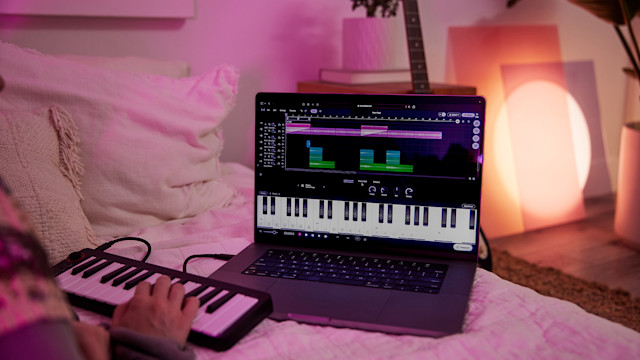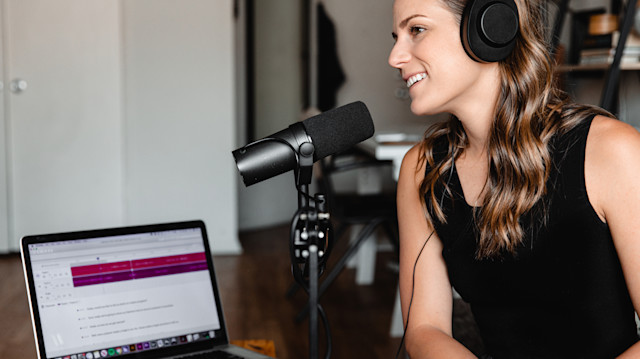Garageband Vs. Soundtrap
September 11, 2024 - What are the differences between the two popular DAWs? This guide breaks down the main features, as well as the pros and cons of both digital audio workstations.

Are you thinking of starting to produce music, but don’t know which platform to begin on?
If you’re planning to start creating with a free or economical digital audio workstation, two DAWs that will likely come up in conversation are Garageband and Soundtrap. In this article, I will give you an unbiased breakdown of the pros and cons of the two workstations so you can decide which platform to start on.
Soundtrap Vs. Garageband: The Main Differences
The main difference between Soundtrap and Garageband is that Soundtrap is a fully online/cloud-based DAW, and Garageband is not. Because of this, Soundtrap is easier to collaborate online with.
Soundtrap: Key Points
Finessed features that are easy to navigate
Works on both IOS and Android
Does not import plugins
Requires a subscription to use the premium features
Meant for desktop/laptop and mobile devices
Requires a subscription to use the premium features
30,000 royalty-free loops sounds/samples and effects
Premium podcasting features onboard
Garageband: Key Points
Apple/IOS devices only
Allows you to import sounds and instruments
Works well on mobile or desktop, but was made with mobile devices in mind specifically
No subscription or upgrades
Can be used offline
No podcasting features
My Experience with DAWS
When I was in late high school (around the time I got my first iPad) I started playing with Garageband. I learned how to record my piano playing into it, and was pleased with how quick and easy it was to make and edit MIDI files. Well actually before that I briefly used Cakewalk, and I was more lost than a needle in a haystack, so I digress…
I then began using a lite version of Cubase, which I received for free with my first interface at Christmas. I quickly became frustrated with the DAW and found it slow to navigate, and even unintuitive at times.
During my college years, I switched over to making music on PC with Reason 10. While this felt better than Cubase to me, it was still a bit odd, the whole concept of the thing. Since I was a late 90’s kid, I never really had the chance to use much equipment that required a plethora of cords and cables: I had grown up in the digital world. So when I switched to Reason, I became quite confused by the idea of turning around the rack to add FX to my tracks...
Shortly after college, I began using Soundtrap. This was my first experience making a full song with loops. I currently use Soundtrap and Logic Pro to fulfill all of my recording needs.
Soundtrap and Garageband: A Comfortable Place to Start
This is all to say that I wish I had known about Soundtrap earlier. While I don’t think Cubase or Reason are bad DAWs, they certainly weren’t a good fit for me at the beginning of my recording career. The interfaces were overwhelming to me…As a flutist who had only lived in the acoustic realm, it was simply too much stimuli!
Next, let’s get into the nitty gritty differences between these two beginner-friendly DAWs.
Sound Packs and Loops
Both DAWs have sound packs, however, they aren’t exactly the same. Soundtrap has themed packs that do a fantastic job of cultivating a specific sound or feeling. Garageband has also producer packs, as well as Live Loops, (smart) drummers, and other extra sounds.
Notable Soundtrap Packs: Calor (Brazilian Phonk), Trap sound packs (High Fashion, Fluid), Liquid D&B, Oppa (K pop), Crate Pianos (Lofi)
Soundtrap Loops: Thousand of loops available, many authentic and raw world sounds inside
Garageband Sounds: Has Live Loops (like Logic does), drummers, sounds for Keyboard/Alchemy synth, and producer packs Garageband feels more open-ended when you are interfacing with it. Soundtrap’s Producer Packs feel more like getting on a train- It helps you directly get from one place to another with your song. On Garageband, I’m more prone to get distracted.
Overall, both platforms have thousands of loops to search from and play with. However, I am partial to many of Soundtrap’s percussive loops and world music samples because they are so authentic and raw.
Changing Keys of Loops
You can set the key of your song on both software, but it is easier to change the key of a loop in Soundtrap than it is in Garageband. To change the key of a loop in ST, you simply select the loop and drag it. In Garageband, if you want to change the pitch of the loop you have to dive a bit deeper and change it by semitones.
Tools, FX, and Other Shared Features
Soundtrap: makes it easy to tweak the character of a voice
Both programs: have a large amount of tools that are easy to use
Both: include pitch correction, EQing, compression, and most other essential tools
While Garageband and Soundtrap have similar plugins and FX in many cases, there are still some differences. One thing I like about Soundtrap is that I can change the character of a voice (a little darker, brighter, or octave up or down or add a fifth) at the touch of a button.
Both programs have an equalizer, mod delay, tremolo, automation, distortion, and dozens of other basic production tools, FX, and pretty much everything you need to get rolling with your music.
Interface/ Workflow
Soundtrap: Easy-to-navigate, high-contrast platform
Garageband: Could stand to have better channels, highly optimized for Apple devices
Both: introduce musicians to production in an accessible way
Despite Garageband being known for its easy-to-use workflow, Soundtraps workflow is even easier. The platform is high-contrast, and I don’t get lost in it.
Garageband doesn’t have great mixing/sampling channels, and I find the sounds of some of the virtual instruments to be just ok at best (cough, drums, cough drums)...
I also don’t like how Garageband (by default) only shows you 8 bars at a time which can make it very difficult to get the big picture of a more involved song or piece. Soundtrap shows about 26 bars by default, making the lay of the musical land easier to imagine.
Both DAWs do an excellent job of introducing new musicians to music production basics without being visually overstimulating or overwhelming. Garageband can be used on Apple Devices only, and Soundtrap can be used on any device. However, Soundtrap as a whole has more extensive controls that I believe to be a bit easier to find/navigate. It also has tutorials that you can click and watch right from your interface.
Soundtrap Workflow Pros & Cons
Ability to tweak and fine-tune
Better workflow experience with the interface
Works well on any web browser and device
Real-time collaboration across states or even countries
Better for podcasting: Has a dedicated podcasting section
Ability to record to the cloud
Fast and easy for those who do many projects at a time
Tracks can be edited simultaneously in Soundtrap, which means that two producers can tweak the final product- at the same time, in real time. This means that Soundtrap takes the cake for being the best DAW to collaborate on, especially of the two.
Since Soundtrap works online inside your web browser, there are no hassles or compatibility issues. Conversely, if your internet connection is slow or weak, you may find you have temporary issues when using the DAW.
Edit notes, velocity, tweak, add effects
Garageband Workflow Pros & Cons
Comes preinstalled on many Apple devices
Free
Difficulties collaborating: Limiting in the sense that you cannot collaborate in real-time
Convenient Click and Drag features
Does not work as well for podcasting
Garageband makes life easy because it comes preinstalled on many Apple devices: All you need to do is open it up and get rolling! However, many people are on Android devices, meaning that Garageband can be a bit inaccessible. If I were on my PC and wanted to collaborate with a Garageband producer, it would be much more difficult to swap tracks and make something come to life. Garageband is seamless: that is until it’s not. GB can also have trouble sending MIDI info, but it does a good job recording it.
While Garageband is nice because it is free and relatively simple to use, its biggest downfall is its lack of features. Like many other starter DAWS, it does not offer advanced editing. But sometimes, limitations can serve as creative inspiration. Grimes, for example, produced her album Visions entirely in Garageband.
Take a listen here:
When working in Garageband if you’re having trouble moving something, realize that (most all of the time) you can just click and drag it in. This click-and-drag style is very appealing to those who make music on their tablets.
While both DAWs in this article are targeted at new musicians who are looking to launch their careers, Soundtrap is far less frustrating and distracting than Garageband on the whole.
DAW Mobility & Connections
Garageband can be used offline, whereas Soundtrap can’t. In this regard, if you’re traveling and trying to make music on a plane, or planning to work with a weak internet connection, or even during a power outage, Garageband may be a better bet.
What I like to do is to record blurbs offline with Garageband, and then move them over to Soundtrap later when my internet connection improves or after I get back off the plane.
Soundtrap: A Podcasters’ Powerhouse

One other stand-out feature of Soundtrap in particular is its premium feature of being able to access a podcasting hub for recording. Have you ever tried to record voiceovers with music tools, and come up with overly reverbed, wacky edits? I know I have….
You can record podcasts in Garageband, but Soundtrap makes it quicker and easier. Some of the buttons available in this section of the DAW include transcription of voice tracks, or ‘interview a guest’. It’s quite plug-and-play!
Collaboration & File Sharing
Spoiler alert: Soundtrap is the cutting edge of online music collaborations.
It is more of a hassle to share Garageband files than Soundtrap files when it comes to collaboration. In fact, it can even be difficult to share files with yourself!
For example, I was recently trying to drop a Garageband file I made a long time ago into Logic Pro. There was an error, and I was not able to drop it in, so it had to be re-recorded entirely- What a waste of time! If it had been a Soundtrap file, I would’ve been able to simply open it up and add more. I’ve also had success moving Soundtrap files as audio files into other programs.
Conclusion: Make Some Noise & Check it Out
Whether you decide to start with Soundtrap or another DAW (you wouldn’t do that to us after getting to the very end of this article, now would you?!), remember the best time to start getting creative is today.
Try Soundtrap Premium for free: Click here!
About the author
Aleah Fitzwater is a multi-instrumentalist, songwriter, music journalist, and blogger from Temperance, United States. Aleah holds a Pk-12 instrumental music education degree. Her main instruments are flute, piano, drums, bass, and guitar.
Get started with Soundtrap today!